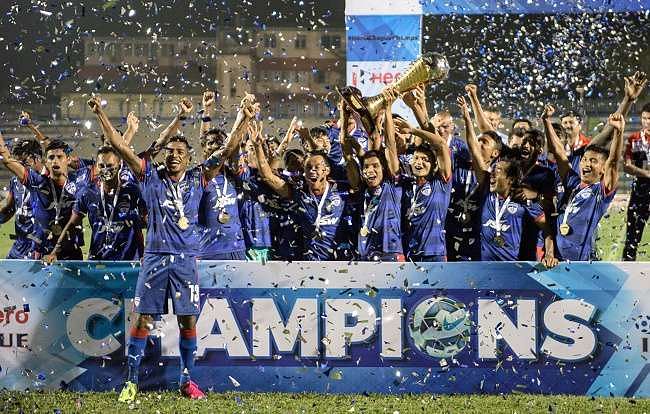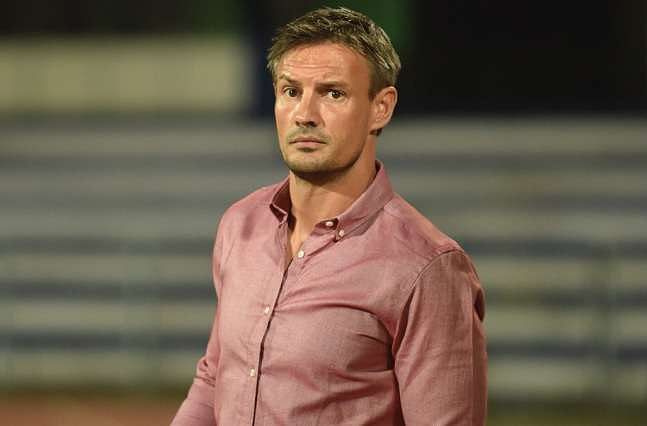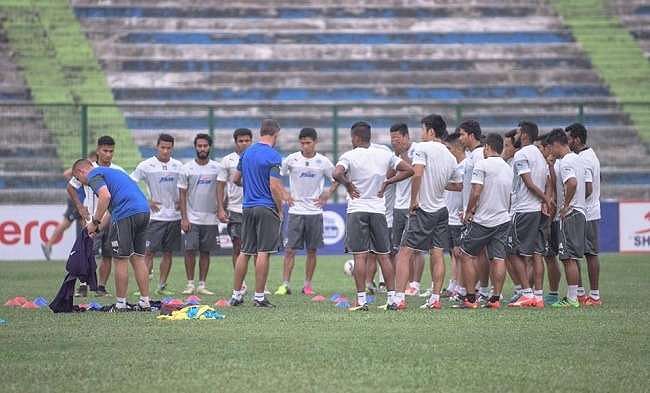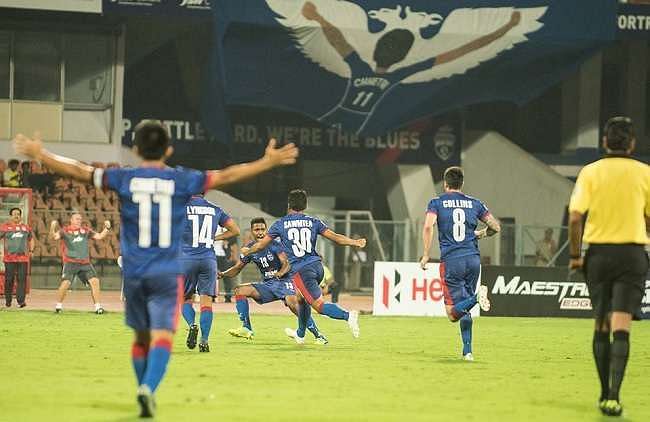
Bengaluru FC's blueprint leads the way as Indian football reaches a crossroads
Three years ago, Bengaluru FC did not exist. On Saturday, they took home their third trophy in three seasons. And they are not done yet.
With two I-League titles in three years, runners-up the last season and a Federation Cup in the bag, the trophy cabinet has been increasing in size every season. The Blues will be looking to add a fourth trophy as they defend the Federation Cup that kicks off on 30 April.
Last season was a bitter pill to swallow for the Blues faithful who came within four minutes of retaining the title. A late goal saw the final match end in a 1-1 draw at the Kanteerava as Mohun Bagan won their first league title after the I-League was formed.
This year, Bengaluru won it back with a game to spare even though the Kolkata club led the table for a majority of the season. The Blues had upped the ante in the business end of the season to take an unassailable lead in the penultimate game at home. The final game in Siliguri saw Mohun Bagan win 5-0 in what was essentially a dead rubber – placating the Mariners faithful to a certain extent.
Mohun Bagan had won the battle having won in both legs. But Bengaluru FC won the war – a campaign that saw them become the only team to win 10 of the 16 games in a heavily truncated league.
How Ashley Westwood won with a team of ‘rejects’
When the AIFF announced in 2013 that a corporate group could gain direct entry into the I-League in a bid to have more clubs outside Kolkata and Goa, JSW Sports jumped at the chance to form a club in Bengaluru. The Bangalore Football Stadium was at their disposal and they went about recruiting players and a head coach.
Ashley Westwood was signed as the manager and he was told about the no-relegation-clause. Bengaluru were safe from relegation for three seasons but it was a matter of personal pride for Westwood to do well.
“There’s a certain amount of pride and personal pressure with relegation or not. Standards will be set high – personal and professional. If those are high, the league table will take care of itself.” – Westwood
Westwood led Bengaluru to the I-League title in the very first season – a tremendous achievement considering the club were not taken seriously at the start of the season. The squad looked far from worthy title contenders on paper.
Thoi Singh, the club’s first signing, was in the second division at the time. Beikhokhei Beingaichho, a key player on the flanks in his debut season with the Blues, was on the fringes of the East Bengal squad having picked up a knee injury that threatened to see the Mizoram-born winger without a team in 2013.
The highly-experienced Johnny Menyongar, who was thought to be over the hill, was signed from Shillong Lajong and he became a dominant force in Bengaluru’s midfield despite his 5’5” frame. Sean Rooney, who had only scored twice for Salgaocar in his one season in India, was signed on as the fourth foreign player.
With a defensive pairing of John Johnson and Curtis Osano who were battle-hardened in English football, Westwood only needed some firepower up front. Robin Singh was also signed after a frustrating three seasons at East Bengal while Sunil Chhetri was signed after his stint with Sporting Clube de Portugal – the club’s major marquee player.
But Westwood was not one to fawn over star signings. In fact, Chhetri did not even start the first two games as Westwood dropped him in favour of the young Malemngamba Meetei (with a little help from Sir Alex Ferguson) because he had impressed the English coach in training. Chhetri accepted the challenge and finished the season as the league’s top goal scorer.
A club built on professionalism and high standards
Ask any Bengaluru FC player what was different about the club compared to the other clubs they had played for and the first aspect they mention is the club’s professional approach to player fitness. Westwood demands a certain level of commitment on the training ground and the pitch and it is what drives the squad to perform.
Training methods used at Premier League clubs were adopted and Bengaluru soon had the aid of GPS devices and heart-rate monitors to compare each player’s data on a day-to-day basis. Westwood himself was given pages and pages of reports detailing how hard each player was working and whether they were exerting too much.
“All Indian players now understand that if you come to our club and learn more about fitness and nutrition then you have a good chance of becoming an international.” – Westwood
The data is accumulated and used to create tailor-made training sessions on a weekly basis. It also defined the recovery periods for players to avoid injuries. Player fitness was a big reason why Bengaluru FC won its maiden title in the 2013/14 season as they ran harder and lasted longer than their opponents in most matches, especially after 70 minutes.
“Throughout the year he has training sessions planned for players,” Eugeneson Lyngdoh explained in an interview. Lyngdoh arrived prior to the second season and has since earned a national team call-up and also won the I-League Midfielder of the Year award two seasons in a row.
“He doesn't say much but he demands a lot, you know. As a player, your duty is to do your best for the coach and that's what we do at the club.”
“He focuses on our diet – what to eat what not to eat,” Thoi Singh said. “We didn’t know about these things earlier.”
Indeed, Westwood is a man who leads from the front. He’s at the training ground at 6 AM and gets home only towards the end of the day where he eventually ends up watching videos of Bengaluru’s games. Even in his blog he mentions how he missed the birth of his son due to his commitments here in India.
In fact, on his return to England, he only spent a few moments with his wife and new-born son before hurriedly leaving for St George's Park National Football Centre to work on his UEFA pro licence!
With his future at the club in doubt, Bengaluru would do well to retain his services while it is understandably tough to hand out yearly contracts to employees when the league is only four months long.
Bengaluru FC’s approach to developing youth players
A number of clubs have made a mockery of the Under-22 rule in I-League. While all clubs are required to field an Under-22 player in the starting XI, many start with a youngster before quickly substituting him for a senior player – sometimes in the first half itself.
“It's a dumb rule,” said Mohun Bagan striker Cornell Glen according to Goal. “It is stupid. It makes absolutely no sense.”
Yet, it does. For the sake of developing young Indian players, it does. Players between the age of 19 and 22 will be left in limbo if the rule did not exist and there would be no incentive to developing young talent.
And Westwood has been the champion of youth players in his squads. A number of players have thrived under him; Udanta Singh (19), Malsawmzuala (18), Shankar Sampingiraj (21), Daniel Lalhlimpuia (18) and Seiminlen Doungel (22) to name a few.
“Younger players have been given game time because the manager believes we’re up to the task.” – Zuala
Udanta even had a training stint with League Two side Oxford United while a teenaged Zuala, who shot to fame with a stunning goal against East Bengal recently, has regularly started important games. Impressed with the club’s progress, India coach Stephen Constantine had even started six Bengaluru FC players in one game during the World Cup qualifiers.
What next for Bengaluru FC in Indian football?
With the advent of the Indian Super League (ISL), Bengaluru FC’s triumphs faded into the background as the I-League was truncated to a five-month season in 2015 and a four-month long league in 2016. FIFA does not allow a country to host two different leagues in the same calendar year in a season and hence the I-League became a January to April/May affair.
AIFF’s talks of an I-League/ISL merger have been mooted of late with 2018 set as a target date. While the format of the league and teams involved is still a big question, Bengaluru FC have shown that their model and philosophy should be one to aspire to.
Should the league become one, ISL teams will only be able to keep four foreign players. Bengaluru have played with less than four foreigners on the pitch plenty of times – even going with an all-Indian lineup in an AFC Cup tie recently as they beat Ayeyawady United in a 5-3 win.
Bengaluru FC’s budget has been blown out of proportion many times, especially on social media. “People say we pay the most and that we have the biggest budget but that is a myth,” Westwood said on ESPN. “We are not Manchester City.”
In contrast, while the Kolkata clubs are rich in history with a legacy of their own, it is a different story off the pitch. East Bengal officials have been involved in the Saradha Group chit fund scam while Mohun Bagan have failed to pay players’ salaries regularly while also failing to find a title sponsor.
Other clubs such as Bharat FC were never in it with a long-term future in mind while new entrants DSK Shivajians are moving in the right direction by benefiting from the same model.
Bengaluru FC’s Soccer Schools has also paved the way as the club looks to develop kids at the grassroots level so they can be inducted into BFC Youth Academies. The sole purpose is to breed youngsters capable of playing in the BFC squads varying from Under-9 to Under-19 before converting them into full-fledged seniors.
The south Indian club has done everything right and even exceeded their own expectations in the past three years. What more they can achieve partly lies in AIFF’s hands as they restructure the league system in India.
Ultimately, the Blues’ success story – both on and off the pitch – is one that cannot be ignored and should be looked up to as the standard for the future of football in the country.
Images courtesy of BFC Media





